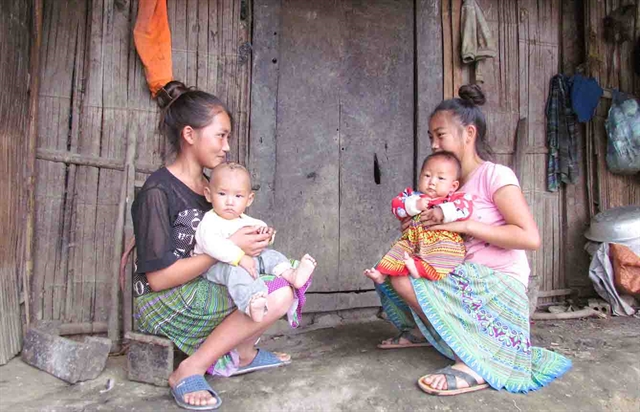 Society
Society

 |
| Two young women became mothers at a very young age in Phong Thổ District, Lai Châu Province. — Photo baolaichau.vn |
LAI CHÂU — Local authorities in the northern mountainous province of Lai Châu have made efforts to raise public awareness of the consequences of child and incestuous marriages.
Nearly 85 per cent of the population in Lai Châu is from ethnic minority groups. In Sìn Hồ District, child marriage used to be common among the community, leading to negative impacts on both children and women.
Tẩn Mý Dao, from Dao ethnic group, living in Tả Ngảo Commune, dropped off school and got married at the age of 16. Now at the age of 22, she already has two sons aged six and three.
“We faced lots of difficulties during the first years of marriage," she told Vietnam News Agency.
"We lived with my husband’s family and lacked experience in child care so our children often got sick. My husband and I often argued.
“Now we have moved out, life is much better. I want to go back to school but cannot because time has been spent on taking care of children.
“I advised my younger sister not to get married at too young an age. It will be a difficult life if you get married and give birth early.”
Tả Ngao Commune is home to 13 ethnic villages, mostly Mông and Dao ethnic groups. Child and incestuous marriages used to be common due to outdated traditional beliefs.
Local villagers believed that if the couple loved each other and doesn’t have the necessities and money to hold weddings, they can buy silver coins to follow traditional customs and live together.
Adolescents who like each other are allowed to live together and have children. These outdated traditions are the underlying causes of poverty that persisted in the villages for many years.
Sùng A Binh, chairman of Tả Ngao Commune People’s Committee, said the commune is one of the areas with the highest rate of child marriage.
Since 2017, local authorities have disseminated the negative impacts of child marriage.
Incestuous marriage no longer exists but the child marriage rate is still high and increasing. In 2022, there were 10 couples married of child age, he said.
The Women's Association of Tả Ngao Commune has strengthened dissemination on child marriage for many years, focusing on adolescents and women in the age of marriage.
Local women's associations and clubs have also encouraged their members to get rich from effective economic models and improve their quality of life.
According to Sìn Hồ District’s authorities, there were nearly 550 couples of child marriage in 2019. The number decreased to nearly 200 couples aged 13 to 17 in 2022.
The Women's Association of Sìn Hồ District established models encouraging its members not to have a third child.
In Cư Nhà La Village, Sùng Phài Commune, Lai Châu City, local authorities knocked on every door to give information that child marriage and incestuous marriages not only affect the health of mothers and children, reduce the population quality, but also are barriers to socio-economic development. Child and consanguineous marriage violations have become part of village conventions.
Incestuous marriages have disappeared in Cư Nhà La Village and there are just a few young married couples.
Identifying child marriage as one of the barriers to local economic development, Lai Châu Province’s authorities have implemented the Government project on reducing child and incestuous marriages in ethnic minority areas in the 2015-25 period.
The province regularly organises conferences and training on the Law on Marriage and Family, the Law on Gender Equality, the Law on Children as well as handing out leaflets, brochures and handbooks on marriage and family law. — VNS




